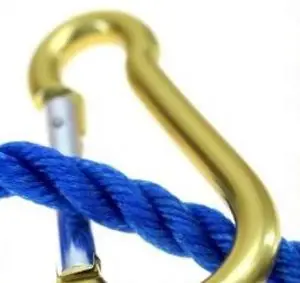If you’re like most people, you probably have a few carabiners lying around your house. Whether you use them for hiking, climbing, or just everyday tasks, it’s important to know how to properly maintain your carabiners. With a little care and attention, you can keep your carabiners in good condition for years to come. Here are a few tips on how to do just that.
How to use a carabiner?
To use a carabiner, first, open the gate. Then pass the rope or other item through the opening, and close the gate. Make sure that the gate is securely closed before using the carabiner. It is important to inspect your carabiner before each use, to make sure that it is not damaged and that the gate is securely closed.
If you find any damage, do not use the carabiner and replace it immediately. When not in use, store your carabiner in a cool, dry place out of direct sunlight. With proper care, your carabiner should last for many years.
What is a Carabiner?
A carabiner is a metal loop with a snap-gate closure, used as a connector. The word “carabiner” comes from the French word “karabijn”, meaning “spring hook”. Carabiners are found in many sports where they are mainly used to connect pieces of safety equipment together or to connect other items to a safety belt or harness.
Carabiners can also be used as keychains or as belt loops. Carabiners have been made from aluminum, steel, titanium, and other metals, but most modern examples are made from an aluminum alloy.
The Different Types of Carabiners
Carabiners are available in many different shapes and sizes, but they all have the same basic parts. The gate is the opening at one end of the carabiner, through which the rope or other item is passed. The frame is the rest of the metal loop, and the nose is the end of the carabiner opposite the gate.
In general, there are three different types of carabiners – straight-gate, bent-gate, and locker.
- The straight-gate is the most basic and common type of carabiner. It is typically used for connecting two pieces of gear or clipping into an anchor. The gate can be opened with one hand using your thumb.
- The bent gate is best suited for tasks that require frequent clipping and unclipping, such as climbing. The ergonomic shape of the bent gate makes it easier to manipulate when you’re wearing gloves.
- Locker carabiners have a locking mechanism that prevents the gate from accidentally opening. They are often used in situations where safety is a concern, such as rappelling or belaying.
How to Care for a Carabiner
Carabiners are an essential part of any climber’s gear, and while they may seem like simple devices, they require regular maintenance to function properly. Here are a few tips on how to care for your carabiners:
- Inspect your carabiners regularly for wear and tear, and replace them if necessary.
- Clean your carabiners with soap and water after each use, and dry them thoroughly.
- If you use your carabiners in salt water, rinse them with fresh water as soon as possible to prevent corrosion.
- Store your carabiners in a cool, dry place out of direct sunlight.
- Do not expose your carabiners to extreme temperatures.
How to Inspect a Carabiner
Although carabiners are strong, they are not indestructible. It is important to inspect your carabiner regularly to ensure that it is in good working condition. Check for any signs of wear and tear, including cracks, bent gates, or excessive scratches. If you notice any damage, retire the carabiner and replace it with a new one.
How to Clean a Carabiner
Climbing carabiners see a lot of abuse. They get battered against the rock, dragged through chalk and dirt, and exposed to the elements. Over time, all that grit and grime can start to affect a carabiner’s performance. To keep your ‘biners functioning properly, it’s important to give them a thorough cleaning every now and then. Here are a few tips on how to clean a carabiner:
- Brush off any loose dirt or debris with a soft-bristled brush.
- Use warm, soapy water to remove any remaining dirt or grime. Be sure to rinse the carabiner well afterward.
- Dry the carabiner off with a soft cloth or let it air dry.
- Once it’s completely dry, apply a light coat of lubricant to the moving parts (if applicable).
To clean your carabiner, avoid using harsh chemicals or solvents, as these can damage the finish or degrade any rubber parts.
How to Store a Carabiner
There are a few different methods for storing a carabiner, depending on what type of carabiner it is and how you plan to use it. If you’re using a carabiner for belaying or rappelling, it’s important to store it in a way that minimizes wear and tear on the locking mechanism. For general camping and hiking uses, simply keeping your carabiner clean and dry will help extend its life.
If you have an auto-locking or auto-blocking carabiner, store it with the locking mechanism engaged. This will help prevent the locking mechanism from being damaged or becoming less effective over time. For all other types of carabiners, be sure to close any gates or straps before storing them. This will help keep the metal parts from rubbing together and becoming worn down.
Conclusion
Now that you know the different types of carabiners and how to clean them, you can make an informed decision about which one is best for your needs. Whether you need a rugged and durable option for rock climbing or a simple and lightweight choice for everyday use, there is a carabiner out there that will fit the bill. With proper care, your carabiner will last for many years to come.
NEXT UP: When Is a Carabiner Worn Out?

